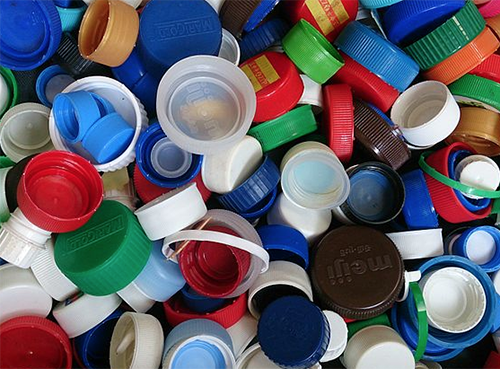All Materials
Plastics
Plastics are materials that use polymers as a main ingredient. (Polymers are substances with a molecular structure made up of repeating units of organic chemicals bonded together.) Plastics can be molded, extruded, or pressed into rigid or elastic forms for a wide range of applications. On average, about 7% of plastics consist of additives used to impart desired functions to the final product, such as resistance to heat, light and impacts; flexibility, color, and more [1]. More than 10,000 chemicals are used as monomers, additives, and processing aids to produce plastics, with about 24% of those substances known to be hazardous and 39% of unknown concern [2].
Most plastics are currently derived from petrochemicals made from fossil fuels (natural gas, oil and coal). Biobased plastics, which are increasingly available, are made of renewable carbon from biomass. First-generation biomass feedstocks, which include starch and sugar crops (corn, cassava, sugar cane, and sugar beet), support most commercially available bioplastics. Second-generation feedstocks, which are more sustainable and have a lower carbon footprint, are becoming available. They include cellulose from forestry residuals, agricultural waste, and purpose-grown crops such as grasses.
For single-use disposable plastics, which include most food and beverage packaging, a recent analysis concluded that 30% could be eliminated outright, 20% could be substituted with more sustainable materials, and 20% could be recycled. Less than 10% of all plastics are currently recycled [1]. Only a few types of plastics have serious recycling potential. But progress is being made to improve recycling potential of common articles. For example, fast food companies can recycle food handling gloves if they are made from polyethylene rather than vinyl plastic.
Material Preference
Preferred plastics will have some or all of the following characteristics:
- They are produced from renewable feedstocks [3, 4], ideally from second-generation biomass. Or, they are produced from non-virgin (recycled) petrochemical plastics made from mono-material plastics low in additives [5].
- The chemicals used in the manufacturing lifecycle of the plastics are of lower concern for health and environment [1].
- They are mono-materials, i.e. they are comprised of a single plastic type rather than multiple layers of materials, do not contain coatings, and are low in additives [5]
- Products are non-fluorinated. [6]
- Products are industrially composted or recycled after use.
Commonly used food-contact plastics include:
(in order of higher to lower chemical footprint [3]):
Polylactic acid (PLA) is a biobased plastic and thermoplastic polymer derived from plant sources, such as corn starch or cassava. PLA is biodegradable under industrial composting conditions.
Polyethylene (HDPE, LDPE, and LLDPE) is a polyolefin plastic available in several varieties. High-density polyethylene (HDPE) is commonly found in hard plastic containers and bottles. Low-density polyethylene (LDPE) is widely used in food contact tubing, plastic bags and wrap, disposable gloves, and soft bottles. Linear low-density polyethylene (LLDPE) is a co-polymer with superior performance for plastic tubing.
Polypropylene (PP) is polyolefin plastic. Polypropylene is a durable plastic with high chemical resistance, and is commonly used in food packaging.
Polyethylene terephthalate (PET or PETE) is a type of polyester thermoplastic commonly used in containers for liquids and foods.
Polyvinyl chloride (PVC) is a flexible vinyl plastic is widely used in food contact applications. In order to impart flexibility to the normally rigid PVC, chemical additives known as plasticizers must be added in large amounts that range from 10% to 50% of the material by weight. Flexible vinyl is used in food processing equipment such as conveyor belts and plastic tubing, and in packaging such as cap gaskets for glass bottles and jars. A major concern with PVC products is the transfer of phthalate and non-phthalate plasticizers from the food contact material into food and beverage products [7]. PVC has a relatively large chemical footprint [1] and should be avoided in all food contact applications.
Polystyrene containers (such as "clamshells"), lids, bottles, trays, are commonly made with polystyrene. Expanded polystyrene (EPS) foam (commonly referred to as StyrofoamTM) is still widely used in food contact. Very few facilities recycle polystyrene, and it has a relatively large chemical footprint [3].
References
Supporting Information:
[1] Geyer, R., Jambeck, J.R., & Law, K.L. (2017). Production, use, and fate of all plastics ever made. ScienceAdvances. 3:e1700822. https://dx.doi.org/10.1126/sciadv.1700782.
[2] Weisinger, H., Wang, Z., & Hellweg, S. (2021). Deep Dive into Plastics Monomers, Additives, and Processing Aids. Environmental Science & Technology. 55(13), 9339-9351. https://doi.org/10.1021/acs.est.1c00976.
[3] Rossi, M., & Blake, A. (2014). Plastics Scorecard. Clean Production Action.
[4] Geueke, B. (2014). Dossier - Bioplastics as food contact materials. Food Packaging Forum, April, 1–8. https://doi.org/10.5281/zenodo.33517
[5] Geueke, B., Groh, K., & Muncke, J. (2018). Food packaging in the circular economy: Overview of chemical safety aspects for commonly used materials. Journal of Cleaner Production, 193, 491–505. https://doi.org/10.1016/J.JCLEPRO.2018.05.005
[6] Neltner, T., Maffini, M., & Bruton, T. (2021). Beyond paper: PFAS linked to common plastic packaging used for food, cosmetics, and much more. Environmental Defense Fund.
[7] Carlos, K. S., de Jager, L. S., & Begley, T. H. (2018). Investigation of the primary plasticisers present in polyvinyl chloride (PVC) products currently authorised as food contact materials. Food Additives and Contaminants - Part A Chemistry, Analysis, Control, Exposure and Risk Assessment, 35(6), 1214–1222. https://doi.org/10.1080/19440049.2018.1447695
See full list of resources here.
Information last updated: 11/2/2021


